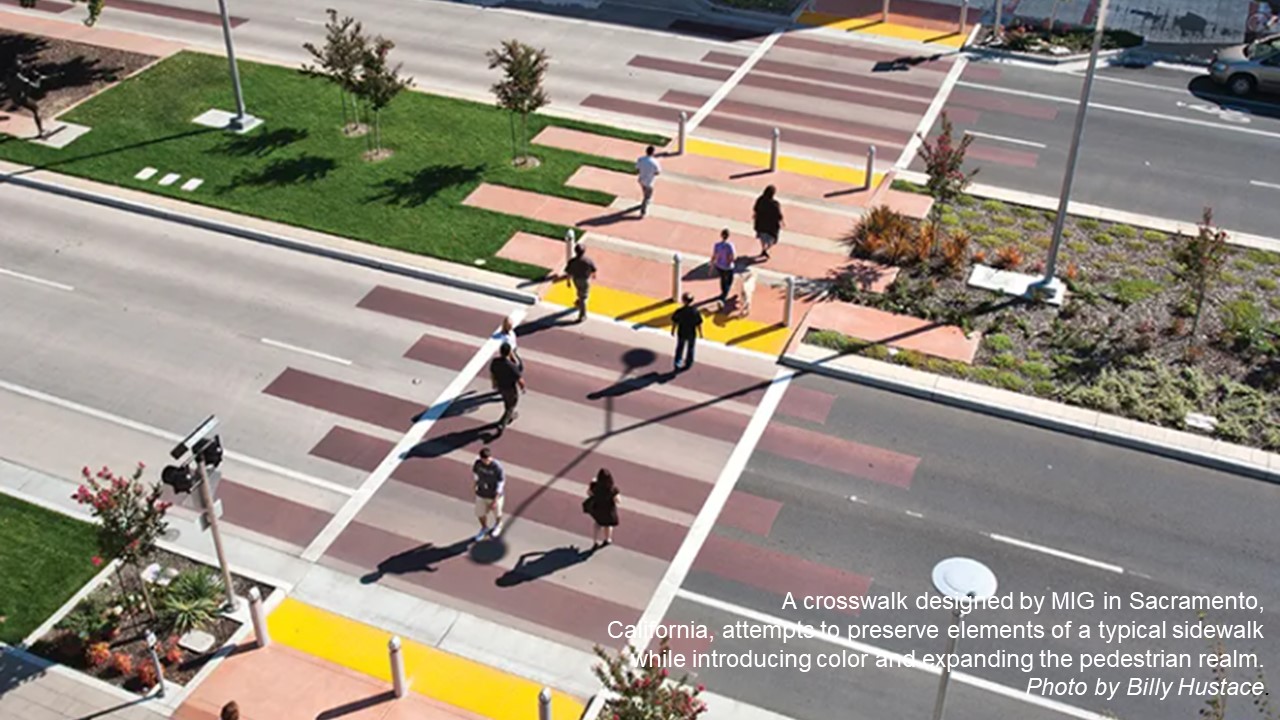by Timothy A. Schuler
CREATIVE CROSSWALKS ARE INCREASINGLY POPULAR—EXCEPT AMONG THE DISABLED.
Viewed by both designers and departments of transportation as an inexpensive way to improve the public realm, street murals that embellish or sometimes even replace traditional crosswalks have become staples in the placemaking playbook. Over the past two decades, artistic crossings have popped up in New York; Charleston, South Carolina; Chattanooga, Tennessee; Oakland, California; and Des Moines, Iowa; to name a few.
City transportation officials have said these street murals, often funded through Bloomberg Philanthropies’ Asphalt Art Initiative, improve pedestrian safety by slowing traffic and benefit communities by promoting public art. But according to a group of eight United Kingdom-based disability rights organizations, crosswalks that diverge from standard street markings pose real dangers to people with disabilities.
In an open letter sent to London’s mayor this past September, the organizations, which included Transport for All and Inclusion London, argued that the city’s “colourful crossings” pose safety and accessibility concerns for individuals who are visually impaired, neurodivergent, or are living with dementia—a population that is already at higher risk of being injured in a vehicle collision. “The use of black and white in traditional pedestrian crossings offers high contrast, which is essential for people with low vision,” the letter stated. The groups also criticized the program for failing to engage the disabled community and argued that the new crossings would prevent disabled persons from using public space.
In response, London’s mayor temporarily paused the installation of new street murals. In the United States, however, such projects continue apace. Last September, the same month the open letter was penned, Bloomberg Philanthropies announced 26 new Asphalt Art projects, including nine “intersection and crosswalk murals,” in places such as Billings, Montana; Kodiak, Alaska; and Niagara Falls, New York.
Those cities should think twice before altering existing crosswalks, says Kathryn Carroll, who works as a disability training coordinator at the Association on Aging in New York and sits on the board of the Disability EmpowHer Network, which pairs disabled girls with disabled mentors. Carroll was born with albinism and is visually impaired. She relies on the consistency and high contrast of a traditional crosswalk to know where to cross the street safely.
“For me, when I’m crossing a street, I’m looking for something that indicates that it is meant to be crossed,” she says. “I do use my usable vision, so if there’s a change in the road surface, in my mind, I think, okay, that could be a hole, that could be a patch, that could be a piece of garbage. That could be a lot of things, so maybe I want to avoid that.” In the winter, when snow often covers up the curb cuts, a painted crosswalk is sometimes the only cue Carroll has to locate a safe crossing.
Despite the experiences of people like Carroll, safety concerns around artistic crosswalks have tended to be dismissed in the United States. In 2019, when the Federal Highway Administration requested that a rainbow-painted crosswalk in Ames, Iowa, be removed, the city council voted unanimously to keep it. Smart Growth America’s Sean Doyle seemed to speak for many a designer and tactical urbanist when he wrote, “USDOT claims that these ‘non-standard crosswalks’ have the ‘potential to compromise pedestrian and motorist safety’ by ‘[diminishing] the contrast between the white lines and the pavement.’… [But] USDOT has been unable to provide any evidence that colorful pavement markings within crosswalks could have an adverse impact on safety.”
It is true that specific research on the impact of artistic crosswalks on disabled persons is lacking. Yet in its letter to London’s mayor, Transport for All cites the British government’s own design standards, which caution that “bold surface patterns can be disorienting or misleading” for visually impaired persons and “should therefore be avoided.”
What happened in London with regard to engagement is “very often what’s happening” in other cities too, says Alexa Vaughn, ASLA, a landscape architect at MIG and the founder of Design with Disabled People Now, an online resource for landscape architects and other design professionals. “Anything that’s designed for access and safety is not actually including the people that it will affect most.”
Deaf since birth, Vaughn has worked on creative crosswalk projects, and she sees their benefits, particularly as opportunities for neighborhood storytelling. She says cities may not need to put a permanent moratorium on street murals but do need to educate themselves about their drawbacks and include disabled people in their planning processes.
One solution, Vaughn says, may be to preserve the most important safety elements of the traditional crosswalk—linear striping, high-contrast colors—in any design, as MIG did for a recent project in Sacramento, California. But it also may be time to separate street murals and crosswalks altogether. “Maybe the crosswalk itself is not the best place,” Vaughn says. “There are a lot of options. Art can go anywhere.” READ THE ARTICLE IN LAM

